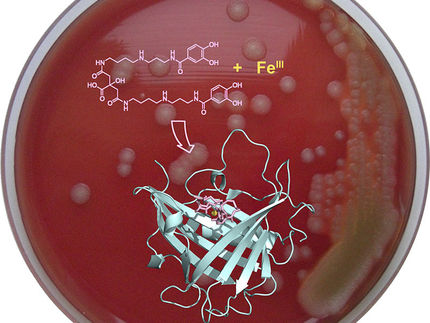U-M researchers identify potential target for anthrax drug
Researchers at the University of Michigan have identified new targets for drugs that could potentially treat anthrax, the deadly infection caused by Bacillus anthracis.
The team, led by David Sherman, a faculty member at the U-M Life Sciences Institute and a professor in the departments of medicinal chemistry, chemistry, and microbiology and immunology, found a new way to block the bacteria's ability to capture iron, which is vital to its survival and its disease-causing properties.
By discovering the mechanism by which B. anthracis obtains iron, the researchers are now able to search rapidly for powerful new antibiotics to effectively treat or prevent deadly anthrax infections. Not only does this finding open the door to possible treatments for anthrax infections, it also indicates possibilities for discovery and development of powerful new anti-infective agents.
"This organism continues to be a serious security threat, as there are inadequate responses to natural or engineered drug-resistant forms of the micro-organism," said Sherman.
This work highlights studies on a new drug target that could lead to development of broad-spectrum antibiotics, which are urgently needed to respond to the increased incidence of drug-resistant infectious agents like anthrax.
While an actual treatment for anthrax remains several years away, according to Sherman, the researchers are using high-throughput screening in the Center for Chemical Genomics at the Life Sciences Institute to identify the most effective potential drugs.
"We are already following active extracts from a large natural products library and hope to have new structures of antibiotic molecules very soon," Sherman said. "Our efforts are part of a major program funded by the Great Lakes Regional Center of Excellence for Biodefense and Emerging Infectious Disease to identify new small molecule antibiotics and vaccines against biowarfare agents and other high-risk infectious microbes."
The current study has inspired the team to take a similar approach, also in collaboration with the Center for Chemical Genomics, in the search for new antibiotics active against methicillin-resistant Staphylococcus aureus, a multi-drug-resistant staph infection.
The anthrax findings were published in the Journal of Biological Chemistry. Sherman and graduate student Tyler Nusca co-authored the paper with Philip Hanna in U-M's Department of Microbiology and Immunology and Andzrej Joachimiak at Argonne National Laboratory.
Most read news
Other news from the department science

Get the life science industry in your inbox
By submitting this form you agree that LUMITOS AG will send you the newsletter(s) selected above by email. Your data will not be passed on to third parties. Your data will be stored and processed in accordance with our data protection regulations. LUMITOS may contact you by email for the purpose of advertising or market and opinion surveys. You can revoke your consent at any time without giving reasons to LUMITOS AG, Ernst-Augustin-Str. 2, 12489 Berlin, Germany or by e-mail at revoke@lumitos.com with effect for the future. In addition, each email contains a link to unsubscribe from the corresponding newsletter.
Most read news
More news from our other portals
Last viewed contents
Why antidepressants don't work for so many - Northwestern research finds drugs aim at wrong target
Epidermolytic_hyperkeratosis
Brodmann_area_28
Dihybrid_cross
ProteoNic and Fraunhofer IME sign Research License and start collaboration on protein expression in plants
Beckman Coulter to Acquire Diagnostic Systems Laboratories, Inc. - Company Seeks to Gain Leadership in Specialty Endocrine Testing
QIAGEN completes second U.S. submission for companion diagnostic to guide treatment decisions in colorectal cancer






















































